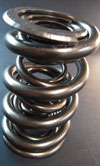Changing valve-spring specifications to save money
 For Morgan Lucas Racing's John Stewart, tuner for second-year NHRA Top Fuel driver Shawn Langdon, the change from titanium valve springs to steel units was due to the cost. "A set of titanium springs is about $1500, and we can get a set of steel springs for about $500. They seem to last just as long," Stewart says.
For Morgan Lucas Racing's John Stewart, tuner for second-year NHRA Top Fuel driver Shawn Langdon, the change from titanium valve springs to steel units was due to the cost. "A set of titanium springs is about $1500, and we can get a set of steel springs for about $500. They seem to last just as long," Stewart says.
"With the economy and money as tight as it is, we're trying to save as much as we can. The cost difference of $1000 is a big deal. You can buy a lot of sets of steel valve springs for the difference in cost."
While some of his compatriots believe there is a penalty to be paid in weight, Stewart says he hasn't noticed any difference. "We changed the valves at the same time we changed the springs, going to a heavier valve. We went to the steel valve spring, and my car still revs up the same as it did prior to that," he says.
With the more expensive titanium springs, Stewart was getting about 30 runs down the 23, 1000-foot dragstrips the NHRA visits in 2010, With the steel valve springs, he says, "We probably make 25 runs at $500 per set maximum, so we're saving a tidy sum.
"We have the most wear - and the most trouble we have is when we get down to the finish line - it hits that rev limiter, takes the mag out and then it starts floating everything. Then the engine wants to kill the valve spring. To counterbalance our problems we just try not to smoke the tyres, which ultimately stops forward momentum," he says.
Stewart is using a triple spring from PAC. He says the most wear on his valve springs is on the outer spring, "because that is where it gets most of the heat.
"The double springs inside aren't that stout a spring, but the engine picks on the ends of the steel ones, too," he explains. "It'll break the ends off a lot. The valve spring still checks out all right (at the end of a run) but you have to get it out of there because on the next lap it's going to break and you're going to drop an air intake and ruin the whole engine. If you drop an intake, it could cost you $60 grand, and it could blow the blower out and knock the rods out."
Stewart doesn't relish those kinds of expenses for his team and makes sure his crew maintains and checks the valve springs as an essential part of every run. "Every single run, we take them apart and make sure there is no wear to the ends and check the seat pressure of about 425lb.
"We ran the same pressure with the titanium valve springs - there is no difference," he says. "The only thing that has changed is we are using the heavier steel spring that is maybe a little less durable than the titanium - by about five runs - but the spring costs substantially less.
If there is a physical difference, it's simply in colour, as there is more of a silver colour to the titanium and the steel is darker. The weight difference is minimal."
Stewart's team changed valve springs before the season started. "We went to the steel and sold off our titanium stock for way less than it was worth - but at least we got something for it, which was better than leaving them on the racetrack! And we switched out to a flat valve, rather than the dished valve we used to run," he says.
"In good air, we couldn't get enough gasket with as much cc's as I had," Stewart reveals. "So I took some cc's away by taking the dish out of the valve, and that made me run a thinner gasket. That way I could make enough power to run a flat valve with the combination I like," along with the steel valve spring.
The combination appears to be working well as the NHRA heads toward its Countdown to the Championship at Indianapolis in September. Langdon is eighth in points and poised to be a title contender.
Fig. 1 - PAC steel valve spring
Written by Anne Proffiit